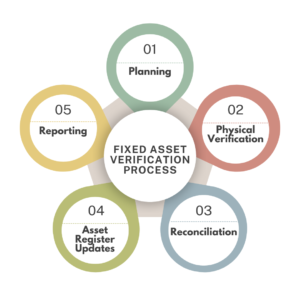Fixed assets form a significant part of an organization’s overall value, and includes buildings, machinery, vehicles, IT assets and more. These assets play a critical role in enabling seamless business operations and generating revenue. To ensure financial transparency, maintain accurate records, and comply with regulatory requirements, organizations must perform regular fixed asset verification.
Periodic physical verification of assets is not just a best practice—it’s also a regulatory necessity. It helps businesses validate the existence, condition, and location of their assets while minimizing the risks of misreporting or asset mismanagement.
This comprehensive guide explores the concept of fixed asset verification, its importance, the role of asset tagging, the verification process, asset verification methods and the creation of verification reports. Let’s get started with the basics and then dive deeper.
What is Fixed Asset Verification?
Fixed asset verification, often referred to as asset inventory or asset audit, is a systematic process of physically inspecting and verifying the existence, location, condition, status and custodian of an organization’s assets.
The primary objectives of fixed asset verification are:
- To confirm the physical existence of assets listed in the balance sheet or fixed asset register.
- To ensure the accuracy of asset records, including asset status, locations, and financial values.
- To discover and prevent misappropriation, theft, or misuse of assets.
Fixed asset verification is crucial for financial reporting, compliance with accounting standards, and safeguarding valuable organizational assets.
Case Study
Read how AssetCues benefitted one of the leading chemicals and fertilizers company in saving more than 70% time and cost in performing physical verification of assets

Case Study
Read how AssetCues benefitted one of the leading chemicals and fertilizers company in saving more than 70% time and cost in performing physical verification of assets

Why Fixed Asset Verification Matters?
Physical verification of fixed assets is necessary for several compelling reasons:
- Accurate Financial Reporting: Physical verification ensures that asset values are properly adjusted to account for asset losses, damage, or obsolescence. This leads to precise depreciation calculations and accurate asset valuations in financial reports, enhancing their credibility and reliability.
- Preventing Misappropriation: Regular verification helps detect and prevent asset misappropriation, theft, or unauthorized transfers. By implementing better processes based on the findings of physical verification, organizations can exert better internal control over assets.
- Maintenance and Upkeep: Verification allows organizations to assess the condition of assets accurately. This information is essential for planning maintenance and repairs, ensuring assets remain in good working order.
- Compliance: Many regulatory bodies and accounting standards require organizations to conduct periodic asset verification. Compliance with these regulations is essential for better corporate governance and maintaining transparency.
- Optimize Asset Utilization: Identify underutilized, idle, or redundant assets, enabling better resource allocation and improved operational efficiency.
- Supporting Asset Lifecycle Management: Provide valuable data for asset lifecycle analysis, including maintenance planning, replacement scheduling, and disposal decisions.
- Facilitating Audits: Simplify external and internal audits by providing reliable, verified asset data and ensuring transparency in asset management practices.
Perform Fast and Accurate Physical Asset Verification – Every Time
AssetCues has helped transform asset verification and reconciliation processes for many Fortune 500 Companies
Perform Fast and Accurate Physical Asset Verification - Every Time
AssetCues has helped transform asset verification and reconciliation processes for many Fortune 500 Companies.
Asset Verification Methods
There are two physical asset verification methods – Wall-to-Wall (W2W) and File-to-Floor (FTF) verification
-
Wall-to-Wall (W2W) Asset Verification
-
Objective: Establish or update a complete and accurate asset register, especially when records are outdated, incomplete, or nonexistent.
-
Process: Every asset is physically inspected, whether recorded in asset register or not. This comprehensive audit creates or refreshes the asset register from scratch.
-
Typical Use Case: Ideal for organizations lacking reliable asset records or facing major discrepancies. Though time-intensive, it provides a baseline for asset management.
-
-
File-to-Floor (FTF) Asset Verification
-
Objective: Validate the accuracy of an existing asset register by ensuring listed assets align with those physically present.
-
Process: Information in the asset register (“file”) is cross-referenced with physical assets on-site (“floor”), resolving any discrepancies of missing or additional assets.
-
Typical Use Case: Suitable for organizations with an established asset register, offering a more efficient and focused verification process.
-
Key Differences
- Scope: W2W includes all assets, even unrecorded ones, while FTF focuses on listed assets.
- Purpose: W2W creates or refreshes the register, while FTF ensures its accuracy.
- Resource Intensity: W2W is resource-intensive, while FTF is leaner.
- Frequency: W2W is conducted occasionally to establish baselines, whereas FTF can be done regularly (e.g., quarterly or annually).
Understand the asset verification methods and their differences in detail >>
Automation of Asset Verification through Tagging of Assets
Asset tagging is a crucial step in automation of the fixed asset verification process. Asset tagging involves affixing unique barcode, QR code, or RFID tags, to each asset.
As these tags are machine readable, they bring automation in asset identification and physical verification. They also serve as a bridge between the physical asset and the asset register. Here’s why asset tagging is essential:
- Quick Identification: Tags enable rapid identification of assets during the verification process. A quick scan/reading of the tag helps identify the assets efficiently.
- Error Reduction: Human errors in asset identification can lead to discrepancies. Asset tagging reduces the risk of errors, ensuring that the asset verification is accurate.
- Automated Movement Recording: Transfers can be recorded accurately and automatically when assets are moved, mitigating unrecorded transfers and further enhancing the efficiency of asset register.
Incorporating asset tagging into the verification process significantly improves efficiency, reduces errors, and enhances the overall reliability of asset data.
Barcode Asset Tracking vs. RFID Asset Tracking in Fixed Asset Verification
Barcode asset tracking and RFID asset tracking are two widely used technologies that help businesses automate physical verification and asset identification processes. They reduce manual effort, improve accuracy, and make tracking assets more efficient.
Barcode asset tracking
Barcode asset tracking involves attaching barcode labels to assets, which can be scanned using a mobile device or a barcode scanner. When scanned, the barcode instantly retrieves asset details, making physical asset verification faster and reducing human errors. This method is cost-effective and easy to implement, but it requires scanning each asset individually.
RFID asset tracking
RFID asset tracking uses special tags that can be read automatically when assets are within range of an RFID reader. Unlike barcodes, RFID does not need direct scanning, allowing multiple assets to be verified at once. This speeds up physical asset verification significantly, especially in large facilities.
Both technologies simplify asset tracking, reduce paperwork, and improve the accuracy of asset records, helping businesses maintain a reliable asset identification system.
Fixed Asset Verification Process: How to Conduct Physical Verification of Fixed Assets
Fixed asset verification process involves five key steps:
For a detailed reading – Click on “Fixed Asset Verification Process – A step by step guide for success”
-
Planning:
Define the verification scope, appoint a team, set timelines, prepare equipment, compile asset lists, and train personnel.
-
Physical Verification:
Visit asset locations, verify existence, condition, location, and user details, affix or scan asset tags, and cross-check with records.

-
Reconciliation:
Compare findings with the asset register, identify discrepancies (missing, additional, or incorrect assets), and investigate causes.
-
Asset Register Updates:
Adjust records to reflect verified details, including status, location, and condition changes.
-
Reporting:
Document verification findings, discrepancies, corrective actions, and process improvement recommendations.
Regular verification (annual or biennial) enhances asset tracking, financial accuracy, and operational efficiency, making it an essential practice for organizations.
Audit Evidence for Accurate Physical Verification
Ensuring the accuracy of fixed asset verification requires robust audit evidence to confirm asset existence, condition, and ownership. Key types of audit evidence include:
-
Asset Photographs
- Visual proof of asset existence and condition.
-
Asset Identification
- Scanned or tagged asset IDs for accurate tracking.
-
Signed-Off Reports
- Verification reports signed by asset custodians.
-
Movement Register
- Records of asset movements to explain discrepancies.
-
Maintenance and Service Records
- Evidence of asset condition and usability.
-
Audit Trails
- System logs tracking asset changes and transactions.
-
Internal Confirmations
- Employee confirmations for assets not physically verified.
-
External Confirmations
- Third-party confirmations for externally held assets.
-
Procurement and Invoice Records
- Proof of asset acquisition and verification.
-
Disposal and Write-Off Records
- Documentation ensuring removed assets are not in active records.
A well-documented verification process strengthens asset management, improves compliance, and mitigates audit risks
Fixed Asset Verification Report
A Fixed Asset Verification Report is crucial to document and report the findings of a physical asset verification. It provides a clear insight on assets verified, assets not found and additional assets; their condition, location, and any discrepancies found when compared to the asset register. This report ensures accuracy in asset identification and helps organizations maintain reliable asset records.
A well-structured report typically includes:
- Summary of the Verification Process – An overview of how the physical verification was conducted, including the scope, timeline, and methodology.
- Asset Details – A list of assets verified, including their unique identification numbers, locations, and conditions.
- Discrepancy Report – Information on missing, additional, or unaccounted-for assets, along with possible reasons.
- Reconciliation Actions – Steps taken to address discrepancies, such as updating records, relocating assets, or investigating missing assets.
- Sign-Off and Approvals – Authentication by asset custodians or owners to confirm the verification results.
A Fixed Asset Verification Report improves audit compliance, enhances asset management, and helps organizations make informed decisions about asset utilization and maintenance. Regular reporting ensures transparency and minimizes financial and operational risks.
Fixed Asset Verification FAQs
How Often Should Fixed Asset Verification Be Performed??
The frequency of asset verification can vary depending on the organization’s size, industry, and internal policies. However, a common practice is to conduct a full verification of fixed assets at least once a year.
Annual audit helps ensure the accuracy of asset records and financial reporting. Additionally, organizations may perform partial verifications or spot checks more frequently, especially for high-value assets or in industries with highly mobile assets.
Ultimately, the frequency of asset verification should align with an organization’s risk tolerance and the criticality of asset data accuracy.
How does asset tagging help in automation of physical asset verification
Asset tagging automates physical asset verification by enabling fast and accurate asset identification. By using barcode asset tracking or RFID asset tracking, organizations can eliminate manual checks and reduce verification time by over 70%. Barcodes allow quick scanning, ensuring instant data retrieval, while RFID enables bulk scanning without a direct line of sight. This streamlines verification, minimizes errors, and improves audit compliance
How asset movement recording can improve fixed asset verification?
Automated asset movement recording improves fixed asset verification by ensuring accurate tracking of asset locations and status. By using technologies like RFID asset tracking, every asset transfer is instantly and accurately logged, reducing discrepancies and manual errors. This enhances audit accuracy, prevents asset misplacement, and streamlines reconciliation by providing a clear movement history.



